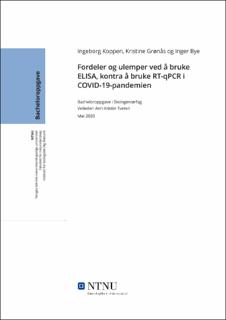| dc.description.abstract | Utbruddet av det nye coronaviruset, SARS-CoV-2, i Wuhan og den påfølgende COVID-19-pandemien, har ført til et stort press på helsetjenester rundt om i verden. Nukleinsyre-amplifikasjonsteknikker (NAAT), slik som RT-qPCR, blir ansett som standarden for påvisning av SARS-CoV-2-infeksjon. Ideelt bør alle som er mistenkt smittet bli testet, men det enorme presset på helsetjenesten og behovet for å gjennomføre mange tester på kort tid, gjøre det imidlertid vanskelig å gjennomføre. I tillegg er det også ulemper med NAAT, som kan føre til falske negative resultat. For å hjelpe til med testingen kan et alternativ være serologiske analyser, som f.eks. ELISA, som kan detekterer antistoffene kroppen produserer ved en virusinfeksjon. Hensikten med denne bacheloroppgaven var derfor å undersøke fordeler og ulemper ved å bruke ELISA, kontra å bruke RT-qPCR i COVID-19-pandemien. For å svare på dette ble det tatt utgangspunkt i ti forskningsartikler som omhandlet temaet. Ut ifra disse artiklene var det klart at RT-qPCR var den mest spesifikke og sensitive analysen tidlig i et infeksjonsforløp, men siden virusmengden etter hvert synker, får man en tilsvarende nedgang i sensitiviteten til RT-qPCR lenger ut i infeksjonsforløpet. Mengden antistoff vil være svært lav, eller udetekterbar, tidlig i infeksjonsforløpet. Antistoffproduksjonen vil imidlertid etter hvert øke, og dermed øker også sensitiviteten til ELISA utover infeksjonsforløpet, men dette kan ta tid. For å detektere flere smittede i både akutt og rekonvalesent fase blir det derfor foreslått å kombinere RT-qPCR og ELISA. Det å påvise smittede tidligst mulig er spesielt viktig i en pandemisituasjon, og derfor vil RT-qPCR fortsatt være den sikreste og høyst prioriterte analysen ved mistanke om SARS-CoV-2. Derimot kan ELISA brukes som et hjelpemiddel om en pasient er mistenkt smittet og/eller har symptomer på COVID-19, men som likevel får negativt RT-qPCR-resultat. Ved å se på forholdet mellom IgM og IgG vil også ELISA kunne gi informasjon om hvor i infeksjonsforløpet pasienten er, eller om en person tidligere har vært smittet. Senere, når pandemien flater ut, vil det være viktig å få et helhetlig bilde over hvor mange som har vært smittet, og da kan også ELISA være til hjelp. | |
| dc.description.abstract | The outbreak of the novel coronavirus, SARS-CoV-2, in Wuhan and the following COVID-19 pandemic, have led to a large strain on the health services around the globe. Nucleic acid amplification tests (NAAT), like RT-qPCR, are regarded as the standard for detection of SARS-CoV-2 infections. Ideally all suspected cases should be tested, but the huge strain on the health service and the need for analysing many samples on a short period of time, makes it difficult to accomplish. There is also disadvantages with NAAT, that can lead to false negative results. To help with the testing, an alternative can be serological assays like ELISA, which can detect antibodies produced by the immune system as a response to a viral infection. The objective in this bachelor’s thesis was thus to investigate the advantages and disadvantages of using ELISA, versus using RT-qPCR in the COVID-19 pandemic. This was done by evaluating ten research papers that addressed the current topic. From these papers it was clear that RT-qPCR had the highest specificity and sensitivity in the early stages of the infection. However, since the viral load gradually decreases, a corresponding reduction of the RT-qPCR sensitivity will be seen in the later stages of the infection. The amount of antibodies will be low, or undetectable, in the early stages of the infection. However, the antibody production will eventually increase, and thus the sensitivity of ELISA also increases, but this can take time. In order to detect more infected cases, both in acute and convalescent phase, it is thus proposed to combine RT-qPCR and ELISA. Detecting infected cases in the early stages of the infection is especially important in a pandemic situation, and thus the RT-qPCR will still be the safest and most prioritised assay when suspecting a SARS-CoV-2 infection. However, ELISA can be used as an aid if a patient is suspected of being infected and/or has symptoms of COVID-19, but still has negative RT-qPCR results. By looking at the ratio of IgM and IgG, ELISA can provide information on where, in the course of the infection, a patient is, or if a person has previously been infected. Later, when the pandemic curve flattens out, it will be important to get a comprehensive view of the number of individuals that have been infected, and then ELISA can be useful. | |
